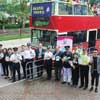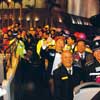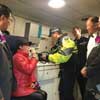Chairman’s
Foreword
The Road Safety Council (the Council) reached its 44th Anniversary this year and it gives me great pleasure as the Chairman of the Council to present its Annual Report for 2017. In 2017, there were about 20,000 additional registered vehicles on Hong Kong’s roads, to make a total of 839,882*, a 2.7 percent rise. The number of fatalities in traffic accidents decreased by 18% from 132 to 108, whilst the total number of casualties was 19,888, similar to the previous year’s figure of 20,132. Taking into account the causation factors of traffic accidents in 2016, the five main themes of road safety publicity were continued in 2017. They are Elderly Pedestrian Safety, Cycling Safety, Anti-Drink Driving and Anti-Drug Driving, Driving Attentively and Student Pedestrian Safety.
Elderly Pedestrian Safety
Elderly pedestrians (aged 65 and above) remained the most vulnerable group prone to traffic accidents among all pedestrians. Of the 108 fatalities in 2017, 37 were elderly pedestrians. The Council believes that the participation of the elderly and related organizations in road safety education is instrumental to our ongoing efforts. To raise awareness among the elderly, the Council partnered with Radio Television Hong Kong (RTHK) to hold a phone-in road safety quiz competition to disseminate the message of Elderly Pedestrian Safety in 2017. Forty teams from elderly centres were invited to participate in the competition. Officiated by the Road Safety Campaign Committee(RSCC) Chairlady, the final round was held in January 2018 together with a drama show with performances by Road Safety Ambassadors and elderly people. It was an entertaining and successful way of conveying road safety messages about the elderly to the public.
Cycling Safety
In view of the continued popularity of cycling, Cycling Safety remains one of the Council’s key priorities. The Council continued to employ qualified trainers to deliver cycling safety training courses to students of 43 primary schools, 18 secondary schools and 4 youth related non-governmental organizations. These courses were well received by the trainees, the parents and the participating schools. In addition, the Council alongside Police Road Safety Teams organized the ‘ Tsuen Wan District Road Safety Carnival’ at Sha Tsui Road Playground, Tsuen Wan including promotion of cycling safety.
Anti-Drink Driving and Anti-Drug Driving
In 2017,”Anti Drink and Drug Driving” remained the focus of the Council. Concerted efforts to publicize and educate road users continued. Promotional banners on flyovers, bus body advertisements, APIs as well as social media were deployed to remind motorists of the tragic impacts of Drink Driving and Drug Driving on the community. There was an encouraging year-on-year drop in the number of drink driving related traffic accidents. Stressing the serious consequences of drink driving, promotional banners and stickers, Television and Radio Announcements in the Public Interest (APIs) and social media reinforced the message of “If you Drink, Don’t Drive!”. In October 2017, the Council in partnership with traffic officers from the Hong Kong Police Force conducted an Anti-Drink Driving publicity campaign in Lan Kwai Fong promoting the message of “If you Drink, Don’t Drive!”. In December 2017, the Council in partnership with Police Road Safety Teams organized the ‘No Drug No Drink Driving and Attentive Driving Bus Parade’ at the Hong Kong Cultural Centre Piazza, attracting wide media coverage.
Driving Attentively
As driving inattentively has been the top causation factor for driver related traffic accidents over the years, the Council continued to promote Driving Attentively to remind drivers to stay alert whilst driving. TV and Radio APIs, posters and leaflets were produced in 2017 to promote the messages of (i) driving attentively and (ii) always be prepared for unforeseen circumstances arising on roads, particularly in the vicinity of road works. In November 2017, the Council and Police Road Safety Teams jointly held the ‘Attentive Driving Kick-off Ceremony and Light Rail and MTR Bus Road Safety Campaign’ in Tuen Mun. The event was successful in reminding the public about road safety and attentive driving.
Student Pedestrian Safety
In the past few years, the casualty rate of student pedestrians (aged 10 to 14) was the second highest when comparing with other age groups. The Council continued to promote Student Pedestrian Safety as one of the five main themes of road safety publicity.
Looking Ahead
In response to several serious traffic accidents that occurred in 2017, the Council decided to enhance publicity to arouse public awareness on the importance of driving attitude by producing TV and radio APIs, posters and leaflets. The Council will continue to be proactive in conveying its road safety messages to the public. Lastly, I would like to express my sincere gratitude to our Council members who again selflessly provided their professional advice and wholeheartedly supported our efforts in mobilizing the community to improve road safety. The Council faces increasing challenges with more vehicles on the road, but I am confident that with our concerted efforts we will make our roads safer. We will strive to achieve our vision – ‘Zero Accidents on the Road, Hong Kong’s Goal’ in collaboration with our community partners.
LAU Yip-shing Chairman Road Safety Council
About the
Road Safety Council
Our Profile
Building on the work of its predecessor, the Standing Conference on Road Safety, established in 1973, the Road Safety Council came into being in 1983 as a government advisory body to promote road safety in Hong Kong. The Council is chaired by the Deputy Commissioner of Police (Operations), with membership drawn from seven government bureaux and departments and six non-governmental organisations. The body is committed to reducing the number and severity of traffic accidents in Hong Kong by formulating road safety initiatives and undertaking education and publicity programmes to encourage everyone to take up responsibility to ensure the safety of every road user. The Council is supported by two committees and two working groups – the Road Safety Campaign Committee (RSCC), the Road Safety Research Committee (RSRC), the Road Safety Publicity Strategy Working Group, and the Road Safety Council Annual Report Working Group. The Road Safety Publicity Strategy Working Group formulates publicity plans for examination by the Road Safety Campaign Committee and is its executive arm for road safety educational and publicity events. The Road Safety Research Committee is responsible for technical research with the aim of enhancing road safety. Each year, the annual report is prepared by the Road Safety Council Annual Report Working Group.
Our Vision
The Council will continue to pursue the Government’s vision of “Zero Accidents on the Road, Hong Kong’s Goal” to make Hong Kong one of the world’s safest cities for road users.
Our Mission
The Council strives to promote and maintain a culture of safe road use, achieved by identifying road safety issues and then initiating and implementing road safety programmes that reduce the number of traffic accidents and severity of injuries. The Council works in partnership with other government departments, transport associations, road safety stakeholders, educational bodies and community organisations. Together, we aim to:
(a) |
Improve the behaviour of road users through education and publicity; |
(b) |
Improve the transport network to create a safer driving and road environment; |
(c) |
Explore new technologies and overseas legislation on road safety to develop effective accident prevention measures; |
(d) |
Build better roads and support the use of safer vehicles; |
(e) |
Engage the community to participate in improving Hong Kong’s level of road safety through partnership programmes; and |
(f) |
Conduct research and analysis to identify traffic accident trends and risk areas. |
Publicity
 |
 |
 |
 |
 |
 |
 |
 |
 |
 |
 |
 |
Achieving our vision of road safety requires a concerted effort in multiple areas, especially publicity. In 2017, the Council strengthened its existing publicity tools and created new platforms to highlight the most pressing road safety concerns in order to raise the community’s awareness of road safety.
Elderly Pedestrian Safety
Publicity activities throughout the year continued to address the safety of elderly pedestrians. The Council worked closely with various stakeholders to conduct education and publicity campaigns in areas with relatively high numbers of traffic accidents involving elderly pedestrians. Much of this work was focused on pedestrian education. The elderly were reminded to use any road crossing facilities provided, such as signal-controlled pedestrian crossings, zebra crossings, footbridges and pedestrian subways. The Council held a phone-in quiz competition from July 2017 to January 2018 in conjunction with Radio Television Hong Kong, involving 40 teams from elderly centres in different areas of Hong Kong. The final competition added the element of a ‘Road Safety Story’ related to our daily life, successfully disseminating messages of elderly pedestrian safety to the public.
Cycling Safety
Cycling safety continues to be a concern among the public. The Council and the government promote cycling safety extensively through various publicity channels. The number of traffic accidents involving bicycles decreased 8.1%, from 2,087 in 2016 to 1,917 in 2017. Pamphlets conveying relevant traffic regulations, responsibilities of cyclists on the road and safety advice and rules when using cycle tracks are widely distributed to the public, including cyclists, pedestrians and employers of staff members who cycle to make goods deliveries. A Road Safety Bulletin entitled Cycling on Cycle Tracks reminds cyclists of safety rules and tips while cycling. In November 2017, the Council and the Police conducted a publicity campaign to promote safe cycling and the importance of wearing a helmet and other protective gear. The ‘Tsuen Wan District Road Safety Carnival’ was held at the Sha Tsui Road Playground in Tsuen Wan. The Council also organised a ‘Safe Cycling Training Programme’ to strengthen primary and secondary students’ knowledge of riding rules and safety tips. The Transport Department operates a Cycling Information Centre (CIC) website (http://www.td.gov.hk/mini_site/cic/en/) to provide the public with one-stop information platform on cycling. The CIC provides relevant information and reference materials such as cycling training, safety tips, applicable traffic signs and road markings, and relevant laws/rules for cyclists and other road users to help promote a safe cycling environment.
Anti-Drink Driving and Anti-Drug Driving
The number of drivers arrested in traffic accidents involving drink driving decreased 7.1% from 255 in 2016 to 237 in 2017, while the number of drivers arrested in traffic accidents involving drug driving was seven in 2017, remain unchanged when compared with 2016. The Council is working to enhance awareness of road safety through publicity and education. To remind people not to drive after drinking and to highlight the adverse effects of drugs on their driving ability, the Council will continue its use of the slogans ‘If You Drink, Don’t Drive’, ‘Drug Driving – Never Risk It’ and ‘Drug Driving – Zero Tolerance’ to disseminate the messages to all sectors of society. The Council reinforces its anti-drink driving and anti-drug driving messages by deploying banners on flyovers and footbridges, stickers on parking meters and advertisements on buses, and conducts publicity events with the Police in entertainment areas throughout the territory. The campaign against drink driving was maintained through a series of proactive programmes. In partnership with the Police, the Council held a publicity campaign in Lan Kwai Fong during October 2017, and ‘Smart Driving Bus Parade 2017’ at the Hong Kong Cultural Centre piazza in December 2017 to promote anti-drink driving and anti-drug driving. These publicity campaigns attracted wide media coverage. The Council will continue to conduct anti–drink driving and anti–drug driving publicity campaigns, and the Police will increase enforcement action to enhance safety awareness among the public and to change undesirable behaviour among drivers.
Driving Attentively
‘Driving inattentively’ has been the top driver contributory factor in traffic accidents for the past five years. Since 2014, the Council has promoted the theme of ‘Driving Attentively’ to remind drivers to pay more attention whilst driving. A new radio API about the ‘Two-second Rule’ was launched on 6 February 2017 to remind drivers to keep a safe distance from the vehicle in front. In addition, a new set of TV and radio APIs, entitled ‘Be Attentive To Road Works, Stay Alert While Driving’ and featuring popular singer Jackson Wan Kwong, was broadcast from 4 December 2017. This set of APIs appeals to drivers to always drive attentively, keep at least a two-second distance from the vehicle in front, pay attention to traffic signs, including road works signs, and discourage the use of mobile phones while driving. In November 2017, the Council and Hong Kong Police Force jointly held the ‘Attentive Driving Kick-off Ceremony and Light Rail and MTR Bus Road Safety Campaign’ in Siu Hong, Tuen Mun. The event successfully spread messages about attentive driving and road safety to the public.
Student Pedestrian Safety
An analysis of pedestrian casualties involved in traffic accidents revealed that the casualty rates involving fatalities and serious injuries among victims aged over 65 was the highest, followed by those aged between 10 and 14. The Council acted to enhance the road safety of this age group by adopting ‘Student Pedestrian Safety’ as one of the main themes of its publicity campaigns. It is of paramount importance to instil the concept of road safety in students. School education is essential for enhancing students’ road safety awareness and reducing traffic accidents involving students. To support schools in implementing road safety education, the Education Bureau (EDB) developed and uploaded relevant learning and teaching resources to the EDB website. In addition, the Road Safety Bulletins are regularly distributed to kindergartens, primary and secondary schools and promoted on the EDB homepage.
Safe Driving and Health Campaign
Every year, to strengthen safe driving skills and enhance health awareness among commercial vehicle drivers, the Transport Department runs a ‘Safe Driving and Health Campaign’. A wide range of services and activities were delivered in the 2017 campaign, focusing on four major themes: ‘Safe Driving Attitude and Behaviour’, ‘Respect Other Road Users’, ‘No Drink Driving and Drug Driving’ and ‘Maintain Good Health Conditions’. The campaign programme included the dissemination of safe driving and health messages through radio broadcasts and other publicity channels, and the provision of free health checks to commercial vehicle drivers.
Targeted Safety Messages
The broadcast of APIs on various media platforms is an important and effective tool to promote road safety messages to the community. A number of APIs that promote the Council’s five main themes – ‘Elderly Pedestrian Safety’, ‘Cycling Safety’, ‘Anti-Drink and Anti-Drug Driving’, ‘Driving Attentively’ and ‘Student Pedestrian Safety’ – will continue to be shown on television. ‘Driving inattentively’ has been the top driver contributory factor in traffic accidents for the past five years. A new set of APIs has been broadcast on TV and radio since 4 December 2017 to remind drivers to be attentive whilst driving.
The Council website
The Council website can be found at:Road Safety Council The Council website describes a range of road safety features and provides online access to all the Council’s publications, useful statistics and links. It aims to disseminate road safety information to the public effectively and recorded a daily average of 2,701 visits in 2017. The Council will continue to explore the use of all media platforms to best reach target audiences with tailored messages.
Education
 |
 |
 |
 |
 |
Safety Through Education
Education and publicity are very important in raising road safety awareness among the public. The Council performs its vital role to educate the public about road safety by identifying focal points, initiating curriculum-based programmes, creating course tools and coordinating the work of other community stakeholders. This multi-agency approach is particularly effective in wide-ranging community education initiatives across all age groups. The concerted efforts of government departments, non-governmental organisations, District Councils, schools and community centres produce a range of road safety education initiatives. Lectures and seminars are given by the Police to various groups and organisations at venues including the Road Safety Bus, Road Safety Towns, schools, centres for the elderly and other community venues. The messages delivered are tailored to specific groups and audiences. For example, road safety tips for the elderly were published and disseminated via the radio phone-in quiz, and cycling training courses were delivered to students to improve their riding skills and road safety awareness. In addition, Road Safety Bulletins, prepared by the Transport Department, are to disseminate road safety advice and messages to all road users to raise their road safety awareness and enhance understanding of traffic regulations and rules. The Road Safety Bulletins are regularly distributed to various stakeholders via district offices, driving schools, public libraries and through other publicity channels. The Road Safety Bulletins are available on the Transport Department’s homepage (www.td.gov.hk/en/road_safety/road_safety_bulletin/index.html).
Youth Education
The Road Safety Towns are owned and managed by the Leisure and Cultural Services Department, while lectures on road safety are delivered by Police Road Safety Teams. The towns transform road safety education into an enjoyable experience, especially for the young and the elderly, in a pleasant and comfortable environment. The towns attracted more than 50,000 visitors of all ages in 2017. They are popular destinations for kindergartens and primary schools, as well as clubs, social service groups and elderly service organisations. Open days with interactive games and performances are regularly held to promote road safety themes.
Hong Kong’s Four Road Safety Towns are:
Pak Fuk Road Safety Town Pak Fuk Road, North Point Enquiries: 2565 5716 Sau Mau Ping Road Safety Town 56 Sau Ming Road, Sau Mau Ping Enquiries: 2379 1194 Sha Tin Road Safety Park 1 Kong Pui Street, Sha Tin Enquiries: 2637 6303 Tuen Mun Road Safety Town Wu Shan Recreation Playground, Tuen Mun Enquiries: 2463 7597 The Road Safety Bus delivers road safety messages to students at schools, residents at housing estates, children at youth centres and old people at elderly centres. In 2017, the bus received more than 12,000 visitors, underscoring the valuable role it plays in road safety education. In addition to raising road safety awareness and developing good practice, we continue to reach out to young people through various media platforms, including YouTube.
School Education
A holistic school curriculum comprising knowledge, skills and values/attitudes is provided for students in accordance with their developmental needs. It aims to nurture in students positive values and attitudes – including responsibility, respect and care for oneself and others, civic awareness and being law-abiding – to support their development as responsible and considerate road users. From pre-school education, students learn how to protect themselves and develop basic safety habits and awareness. Learning elements of road safety education, including understanding and complying with safety regulations, cycling safety, proper use of public transport and common causes of traffic accidents are incorporated into the school curriculum such as General Studies at the primary level and Moral and Civic Education at both primary and secondary levels. To promote road safety education, schools can make use of learning and teaching materials, including educational television programmes and lesson plan exemplars provided by the Education Bureau and web-based resources provided by the Council. Learning and teaching resources on Road Safety have been uploaded to the website of the Moral, Civic and National Education Section of the EDB (www.edb.gov.hk/cd/mcne). In addition, corresponding life-wide learning activities such as the Hong Kong Road Safety Patrol and Safe Cycling Training Programme are conducted to broaden young people’s sense of road safety and strengthen their proper road-use habits. Through participating in the above activities, students develop positive values and behaviour in road use and become responsible road users personally and socially.
Cycling Safety Education
With the continuing growth in the popularity of cycling for short distance travel, as well as recreational, environmental, health and other reasons. The Council, the Police and the Transport Department have promoted cycling safety through a variety of publicity and educational activities. As cycling becomes widespread in Hong Kong, we will continue to boost our efforts in this area. Major recent undertakings have included:
• Broadcasting the ‘Safe Cycling: Rules and Tips’ set of educational videos at public venues and sports institutes, which are viewed by the public, including cyclists, motorists, pedestrians and students. They provide a complete guide to proper and safe behaviour for all road users in relation to cycling. The set of videos is also available on YouTube and at the websites of the Transport Department and the Council. DVDs of the videos have been distributed to all local schools and higher education institutions.
• The distribution of leaflets and souvenirs during safe cycling campaigns held at cycling hotspots to enhance public awareness of cycling safety. For example, the Council and the Force jointly held the ‘Tsuen Wan District Road Safety Carnival’ at Sha Tsui Road Playground in Tsuen Wan. Leaflets and souvenirs were distributed to disseminate safe cycling messages. Furthermore, safe cycling banners have been displayed on cycle tracks to remind cyclists about safe cycling.
• Delivering regular talks in schools and communities to promote the use of cycling safety equipment, and conducting a ‘Safe Cycling Training Programme’ to promote safe cycling among primary and secondary school students. A total of 70 cycling safety training lessons were delivered to 3,581 students in 43 primary schools, 18 secondary schools and 4 youth NGOs to strengthen their cycling skills and safety awareness.
• Giving talks on cycling safety to students and organisations, visiting the four Road Safety Towns and providing practice sessions.
• Publishing leaflets and Road Safety Bulletin on cycling safety to deliver safety rules and tips related to cycling.
Driver Safety Education
In order to enhance awareness of road safety and foster good driving behaviour, the Driving Improvement Scheme has been provided since September 2002. Pursuant to the Road Traffic Ordinance and the Road Traffic (Driving-offence Points) Ordinance, drivers who have been convicted of a serious traffic offence or who have accumulated 10 or more Driving-offence Points (DoPs) within two years are required to attend a driving improvement course provided by a designated driving improvement school. The course is also open to eligible drivers. After satisfactory completion of the course and fulfilment of other conditions, participants have their DoPs reduced by three. In 2017, about 25,600 persons attended the course. Within six months after completion of the course, about 93 per cent of them did not incur new DoPs. A new set of TV and radio APIs was launched on 4 December 2017, reminding drivers to drive attentively particularly at road works. A Road Safety Bulletin, Know More about Traffic Lights, was published to remind drivers of the rules when driving through signalised junctions, including the meaning of various traffic signals and the use of ‘right-turn pockets’ located there. In addition, a Road Safety Bulletin, Safe Driving on Expressways, was published to disseminate safety rules and tips on the use of expressways and strategic routes. Drivers’ particular attention are also drawn to the necessary precautionary action when they encounter temporary traffic arrangements for roadworks on expressways. ‘Driving Inattentively’ has been the top driver contributory factor in traffic accidents for the past five years. In order to change the undesirable behaviour of drivers who cause accidents, HKPF formulated the Selected Traffic Enforcement Priorities 2016 to enhance drivers’ awareness of their responsibility toward the safety of every road user around them.
Elderly Pedestrian Safety Education
In Hong Kong, elderly pedestrians remain especially vulnerable to road accidents. The Council continued to focus many of its seminars, campaigns, bus parades, road safety messages and publicity and educational programmes on this demographic group, emphasising proper road use and crossing technique. In particular, we continue to broadcast the television API on elderly pedestrian safety, reminding the elderly to ‘Love Yourself, Love Your Family, Be a Smart Pedestrian’. The Council also worked closely with Senior Police Call to conduct education in areas with a higher occurrence of traffic accidents involving elderly pedestrians to remind the elderly to use proper road crossing facilities. The Elderly Pedestrian Road Safety Quiz Competition, co-organised by the Council and RTHK 5, was broadcast on RTHK 5 from July 2017 to January 2018. A music video called Be a Smart Pedestrian was produced as the theme song of the quiz competition to promote road safety messages to the elderly. The song was widely heard among the elderly segment of society and was watched many times on the RTHK YouTube channel. Forty teams from elderly centres across Hong Kong were invited to join the competition and Senior Police Call members were engaged as road safety ambassadors. The 2017 campaign attracted much attention from its target audience among the elderly. The Council will continue to make use of the RTHK Radio 5 channel to promulgate safety messages to the elderly in 2018.
Road Safety
Measures
 |
Revision of Code of Practice for the Lighting, Signing and Guarding of Road Works
Pursuant to the Road Traffic Ordinance (Cap 374), the Highways Department (HyD) published in the Gazette on 16 June 2017 the revised Code of Practice for the Lighting, Signing and Guarding of Road Works (the Code). This revised edition is the Fifth Edition of the Code and took effect from 1 January 2018. The Code emphasises that the person responsible shall strive to avoid putting the worksite in a vulnerable situation and to carry out road works in daytime as far as practicable, with sufficient time window and working space for the setting up, maintenance and removal of lighting, signing and guarding and protection measures before, during and after works execution. These practices can help to minimise the risk of the road works being hit by oncoming or passing vehicles.
The major revisions to the Code include:
(1) For road works on public roads with a speed limit of 70 kilometres per hour (km/h) or above (including expressways), the contractors are required to provide shadow vehicles equipped with truck-mounted attenuator (or temporary safety barriers with an appropriate containment level) and a longitudinal safety clearance zone (buffer zone) in front of the works area; (2) Extending the application of shadow vehicles equipped with truck-mounted attenuator, flashing arrow signs, flashing beacons and signage when conducting mobile operations (such as setting up and removing a lane closure, emptying a gully, sweeping/watering, or emergency road surface repairs) on expressways to mobile operations on all public roads with a speed limit of 70 km/h or above; and (3) Upgrading the specification of retroreflectivity on the rear of truck-mounted attenuator on shadow vehicles for better visibility to motorists, and clearly specifying the minimum weight of the shadow vehicle to enhance the protection for workers.
Legislation
and Enforcement
Traffic regulations address the mutual relationships among road users and also the relationship between road users and their surroundings. They aim to promote the safe and smooth flow of traffic on roads. Breaches of regulations are addressed through police enforcement. Enforcement action continued to focus on reducing traffic accidents and improving traffic flow. Experience has shown that our efforts have significantly enhanced road safety. In 2017 there were a total of 2,395,687 enforcement actions, an increase of 12% compared with 2016. Drink driving, drug driving, speeding and illegal road racing remain issues of concern.
Selected Traffic Enforcement Priorities (STEP)
Road Safety is an operational priority for the Commissioner of Police. The Selected Traffic Enforcement Priorities (STEP) have recently been comprehensively reviewed to align its targeting of offences with current traffic characteristics in respect of road safety, traffic flow and traffic offences that affect the community.
Traffic accident and congestion related statistics are regularly analysed to identify areas in which improvements to traffic policies and enforcement strategies can be made.
In 2017, there were 15,725 traffic accidents (TAPI) involving 25,372 vehicles, in which 19,888 persons were injured, including 108 persons killed and 2,214 seriously injured on Hong Kong’s roads. These figures do not include traffic accidents in which no person was injured.
The aims of STEP 2018 are to change irresponsible behaviour by road users that causes accidents or obstructs traffic flow; address issues of community concern centred on irresponsible road user behaviour; and make everyone feel that they have a responsibility to ensure road safety.
In order to further reduce undesirable behaviour that constitutes STEP offences, we will focus on educating the public about road safety, risks caused by the offences and the reasons behind enforcement action.
Pedestrian Safety
Pedestrians continue to be the group most vulnerable to traffic accidents, accounting for 59% of fatalities in 2017. To address this, the Police Force regularly conducts territory-wide pedestrian road safety operations with a view to reducing traffic accidents involving pedestrians, particularly the elderly. Stringent enforcement actions are taken against pedestrians who blatantly jaywalk or who commit other serious traffic offences. In 2017, there were 18,229 prosecutions against pedestrians. Fatalities among elderly pedestrians aged 65 or above decreased by 20% from 46 persons in 2016 to 37 in 2017. The elderly were victims in 58% of all pedestrian fatalities. Alongside the Police’s continuous enforcement efforts, the Council pledges to enhance publicity about the safety of elderly pedestrians.
Cycling Safety
In recent years, cycling has become increasingly popular. Cyclists are vulnerable on roads and injuries in cycling accidents can be very serious. Territory-wide operations are regularly conducted to raise public awareness of cycling safety. Once on the road, cyclists are obliged to obey all applicable traffic laws and are subject to the Road Traffic Ordinance. Cyclists should pay attention to road safety.
Anti–Drink Driving
Drink driving legislation is enforced by testing of breath, blood and urine for alcohol. In 2017, 948 persons were arrested for drink driving offences and the number of traffic accidents involving drink driving decreased from 254 cases in 2016 to 232 in 2017. Since late 2013, the Police have used a Mobile Breath Test Centre (MBTC) to enhance the efficiency and effectiveness of drink driving enforcement. Three MBTCs have been in operation since the end of 2017 to further combat drink driving.
Anti–Drug Driving
The Road Traffic (Amendment) Ordinance 2011 came into effect on 15 March 2012. It empowers police officers to require drivers to undergo a preliminary drug test that includes Drug Influence Recognition Observations (DIRO) and Impairment Tests (IT) if the driver is involved in a traffic accident or has committed a traffic offence when the vehicle is in motion, or is suspected of driving under the influence of specified illicit drugs or other drugs, or driving after use or consumption of specified illicit drugs. The Ordinance also empowers police officers to require drivers to provide a blood or urine specimen if the police officer forms an opinion after conducting preliminary drug tests that the driver’s ability to drive is impaired. In 2017, a total of 109 DIROs and four ITs were conducted. A total of 15 drivers were arrested for drug driving offences.
Public Service Vehicles Related Offences
Territory-wide operations targeting drivers of public service vehicles, such as franchised buses, public light buses and taxis, to enhance their road safety awareness with the aim of reducing traffic accidents and enhancing traffic flow were mounted by the Police at irregular intervals. In 2017, the Police conducted operations in which a total of 485 drivers or passengers were summonsed and 3,637 drivers issued with fixed penalty tickets.
Seatbelt Offences
Wearing a seat belt is an effective way to reduce injury severity in a traffic accident. Seatbelt offences are tackled by territory-wide operations. In 2017, the Police conducted operations targeting seatbelt offences with a total of 652 summons and 6,963 fixed penalty tickets issued.
Road Safety
Funding
Funding
The source of funding for the Road Safety Council’s operations is the Government.
Maximising Resources
For the 2017-2018 financial year, the Government allocated HK$4.7 million to the Council for education and publicity programmes, via the Transport and Housing Bureau. Our Road Safety Campaign Committee (the Committee) devises the work plan and ensures that resources are spent appropriately and effectively. The Committee also ensures that publicity activities meet design parameters and remain within budget. The Council is confident that, with its funding, a well-coordinated and effective action plan to promote road safety can be implemented across all areas of its remit.
Non-governmental
Organisations
 |
 |
 |
 |
 |
 |
The Chartered Institute of Logistics and Transport in Hong Kong (CILTHK)
Comprising about 1,800 members, including experienced managers, government staff, public and private sector corporations and consultancies, the Chartered Institute of Logistics and Transport in Hong Kong (CILTHK) encompasses a diverse spectrum of industries including air, sea and land, for both passengers and freight transportation. The CILTHK regularly organises seminars, forums, conferences, visits and other Continuous Professional Development programmes and events for members. Additionally, it operates a code of conduct with the objective of upholding professional industry standards. The CILTHK also participates in public committees and advisory bodies to comment on transport and logistics-related issues for the Government. In August 2001, the CILTHK joined the Road Safety Council, taking up roles on the Road Safety Campaign Committee and the Road Safety Research Committee. On a regular basis, the CILTHK works closely with the Council and other government departments to improve road safety and ensure that road safety messages reach the industry. For further information, please visit: http://www.cilt.org.hk
Hong Kong Automobile Association (HKAA)
As a member of the Road Safety Council, the Hong Kong Automobile Association (HKAA) provides comment to assist both the Council and the Government in developing new legislation, improving road quality, devising new road safety measures and handling various traffic aspects related to the general protection of road users. The Association is represented on the Council, the Road Safety Research Committee, the Road Safety Campaign Committee and the Speed Limit Review Working Group. HKAA is the most recognised and longest established automobile organization in Hong Kong, having been in existence since 1918. HKAA is a not-for-profit organisation that serves members and road users in Hong Kong. The Association also promotes road safety, assisting road safety campaigns and road safety carnivals organised by district councils. HKAA supports environmental protection, and is devoted to the creation of a superior driving and living environment for Hong Kong residents. HKAA is a member of the Federation Internationale de l’Automobile (FIA), the Federation Internationale de Motocyclisme (FIM) and the Hong Kong Sports Federation and Olympic Committee of Hong Kong, China. As the ASN (National Sporting Authority) in Hong Kong, HKAA’s involvement in motorsport began in the 1950s and is the sole association able to issue race competition licences to members. In addition to this formal role, the Association has been actively involved in the promotion of sporting events, to assist Hong Kong competitors to participate in international events overseas. For further information, please visit: http://www.hkaa.com.hk or Like our Facebook fan page: HKAA
The Hong Kong Federation of Insurers (HKFI)
The Hong Kong Federation of Insurers (HKFI) comprises 136 member companies and is recognised by the Government as the representative body of the insurance industry. It consists of two councils: the General Insurance Council and the Life Insurance Council. Matters related to motor insurance are in the purview of the Accident Insurance Association, which is established under the General Insurance Council. The HKFI liaises with the Financial Services and the Treasury Bureau and the Insurance Authority on legislative and industry matters, and is committed to improving the professionalism of the insurance industry through promotion and refinement of its self-regulatory framework. The HKFI continues to support Road Safety Council activities and initiatives. The HKFI website (www.hkfi.org.hk) provides a link to the Road Safety Council website, providing drivers with useful information on motor insurance, including third-party risks insurance, motor insurance cover under adverse weather conditions, what to do after a car accident occurs and other related topics. The HKFI holds a consistently firm position against drink driving and drug driving. Further, HKFI is preparing to build an electronic platform to authenticate cover note, in order to protect public interest. The HKFI’s dedicated Facebook page, ‘HKFI Smart Union 保聯同學會’ (www.facebook.com/HKFI.SmartUnion/) shares information relating to motor insurance and safety tips for motorists and the public. In 2014, HKFI launched the inaugural Hong Kong Insurance Awards to raise standards across the industry by recognising outstanding performance and innovation, which will encourage more professional services and innovative ideas to better serve the insured public. The HKFI will continue to strive to educate public about insurance and to drive the sustainable development of the industry.
The Hong Kong Medical Association (HKMA)
Formerly known as the Hong Kong Chinese Medical Association, the Hong Kong Medical Association (HKMA) was founded in 1920, and aims to improve medical standards in Hong Kong. At the same time, it provides a platform to maintain friendly and professional relations with registered medical practitioners. With its motto: ‘To Safeguard the Health of the People’, the HKMA has over 10,000 members. Its work centres on the dissemination of medical knowledge, encompassing information regarding the care and wellbeing of road users. In this respect, the HKMA offers medical advice to drivers on the side effects of medication and other safety topics. Medical educational programmes, provided by a dedicated team of volunteer doctors, help publicising the risks of drink driving and drug driving. Press releases, publications, radio and TV programmes, lectures and exhibitions are included in the HKMA programme of activities to distribute life-saving messages. The Association’s activities, including commentary on controversial medical matters, are conveyed through a monthly newsletter. To keep abreast of the latest global developments in road safety research, the Council leverages the HKMA’s affiliation with many international medical groups, including ties to the World Medical Association, the Confederation of Medical Associations in Asia and Oceania, and the Hong Kong Pharmacy and Poisons Board. For further information, please visit: http://www.hkma.org
The Hong Kong Road Safety Association (HKRSA) / Hong Kong Road Safety Patrol (HKRSP)
Founded in 1961, the Hong Kong Road Safety Association (HKRSA) is a voluntary organisation dedicated to the promotion of pedestrian safety. In 1963, the Hong Kong Road Safety Patrol (HKRSP) was established to focus on student pedestrian safety in areas where young people travel to and from school with inadequate road crossing facilities and to assist the Police to publicise road safety issues. As at December 2017, the HKRSP had a membership of 12,404, including students from 323 kindergartens, primary and secondary schools, as well as senior citizens from elderly centres. In addition, 1,650 volunteers serve as safety leaders. In 2017 the HKRSP participated in a number of road safety campaigns and community events. It also provided regulatory and traffic-flow services, social services and spearheaded road safety education among students. Student members who share the mission to promote school road safety education also serve the community in the important role of Road Safety Ambassadors. The HKRSP has also reached out to the Mainland by sharing its experience and expertise with cities and provinces, and mutually supporting the promotion of road safety awareness and the promotion of road safety patrols in schools. The HKRSA and HKRSP cooperate closely with the Police, the Council, Education Bureau, Social Welfare Department and Home Affairs Bureau in common pursuit of a Hong Kong that is safe for road users. For further information, please visit: http://www.rsa.org.hk
Institute of Advanced Motorists Hong Kong (IAM/HK)
The Institute of Advanced Motorists Hong Kong (IAM/HK), established in 1961, is now in its 57th year. The aim of IAM/HK is to improve road safety in Hong Kong through the promotion of safe driving skills and responsible driving attitude, and to provide training intended to improve the standard of driving. IAM/HK is an active member of the Road Safety Council (RSC) and represented on its Road Safety Research Committee, Road Safety Campaign Committee and Working Group on Speed Review. As a non-commercial and non-profit-taking organisation, the IAM/HK conducts advanced training programmes and assessment to the government, commercial fleet and the public through our accredited trainers, in Hong Kong, Macau and the Mainland. IAM/HK organises various safe driving competitions in Hong Kong and the Mainland (such as the “Road Safety Trophy” of one cup water safety driving competition, ‘Treasure Hunt’ competition and economy driving competitions) for cars/containers trucks/motorcycles and other commercial vehicles. We will continue to work along these principles as we believe that when there are more advanced and responsible drivers, we will all be safer on the road. For further information, please visit: http://www.iamhk.org/
Traffic Accident
Statistics
The Council’s programmes and direction are formulated with reference to accident trends and common accident contributory factors. To this end, traffic accident statistics and trends are carefully analysed to determine appropriate measures to mitigate and prevent traffic accidents.
2017 Statistics
An analysis of Hong Kong’s traffic accident statistics for 2017 reveals that 15,725 traffic accidents involved injuries, with a total of 19,888 casualties. On average, 43 traffic accidents with injuries occurred each day during the year and about two people were killed each week. Compared with the previous year, the number of accidents and the number of casualties decreased slightly by 2.32% and 1.21% respectively. Categorising accidents by collision type reveals that the number of vehicle collisions involving pedestrians decreased from 3,172 cases in 2016 to 2,958 cases in 2017. However, cases involving one vehicle colliding with another increased from 7,507 cases in 2016 to 7,648 cases in 2017. While there has not been any significant change in the past decade in the number of traffic accidents involving injuries, there is a downward trend in fatalities. A total of 108 people were killed in traffic accidents in 2017. The Council studies causes and consequences of traffic accidents and maintains a comprehensive traffic accident database to help formulate appropriate road safety strategies. Clearly, pedestrians consistently suffer the highest number of fatalities while private cars are the group most commonly involved in accidents. Of the 25,372 vehicles involved in traffic accidents in 2017, private cars accounted for 8,607, compared with 4,359 taxis, 2,790 light goods vehicles, 2,726 public buses, 2,280 motorcycles, 2,061 bicycles and 2,549 other vehicle types.
Impact of Road Conditions
Over the year, among injuries related to traffic accidents, 27 percent occurred at road junctions and 25 percent occurred at pedestrian crossings. Some 29 percent of traffic accidents happened at night while another four percent occurred around dawn or dusk.
Top five contributory factors in traffic accidents 2017 (from four perspectives)
I. Driver
Contributory Factors |
No. of Drivers |
Driving inattentively |
4,371 |
Lost control of vehicle |
1,821 |
Driving too close to vehicle in front |
1,639 |
Careless lane changing |
1,215 |
Turning right/left negligently |
659 |
II. Casualty (Passenger or Pedestrian)
Contributory Factors |
No. of Casualties |
Passenger lost balance, other than on stairway of bus |
575 |
Pedestrian inattentiveness |
374 |
Crossing road heedless of traffic (other than at crossing) |
256 |
Passenger lost balance, on stairway of bus |
181 |
Crossing road heedless of traffic (at crossing) |
166 |
III. Vehicle
Contributory Factors |
No. of Vehicles |
Unidentified vehicle (hit and run) |
168 |
Mechanical defect |
48 |
Tyre blown out before impact |
9 |
Broken down with hazard warning lights unlit |
7 |
Defective or illegal tyre |
5 |
IV. Environment
Contributory Factors |
No. of Accidents |
Pedestrian negligence |
232 |
Object or animal in road |
89 |
Slippery road (caused by weather) |
69 |
Slippery road (not related to weather) |
56 |
Inadequate light/sign at road work |
19 |
The Way
Forward
Looking Ahead
The Road Safety Council actively assists the Hong Kong Special Administrative Region Government in pursuit of the vision, ‘Zero Accidents on the Road, Hong Kong’s Goal’. With rising levels of vehicle ownership and a growing population, traffic volumes on our roads are expected to keep increasing. The Council will continue to enhance road safety through a three-pronged strategy – public engagement, road engineering and proactive enforcement – to make our roads and community safer.
Spreading the Safety Message
The Council conducts publicity campaigns to enhance awareness of its five road safety themes – ‘Elderly Pedestrian Safety’, ‘Cycling Safety’, ‘Anti-Drink Driving and Anti-Drug Driving’, ‘Driving Attentively’ and ‘Student Pedestrian Safety’ – in order to encourage the public to play its part in ensuring that every road user is safe. Road safety publicity materials are disseminated through social media and different platforms, including television, radio, websites, YouTube and video walls. Promotional imagery is displayed at MTR stations, leaflets are distributed through educational publicity events and campaigns, and banners are hung at the flyovers of main thoroughfares and alongside cycling tracks. Every year, the Council holds an Anniversary Ceremony to highlight the selected road safety theme of the year and to maximise the spread of road safety messages. ‘Safe Cycling: Rules and Tips’, an educational video featuring key safety messages as well as cycling skills and rules on roads and cycle tracks, is broadcast on various channels and is also accessible via the websites of the Council and the Transport Department. The Council’s website is kept up-to-date with the latest news on road safety publicity and campaigns and other pertinent information. This Annual Report, which details the Council’s activities throughout the year, is published along with a series of Road Safety Bulletins focused on specific road safety themes.
Educating Target Groups
The Transport Department disseminates road safety messages to professional drivers through newsletters, seminars, workshops and meetings with public transport operators and trades that use commercial vehicles. It conducts the ‘Safe Driving and Health Campaign’ to enhance safe driving skills and health awareness among commercial vehicle drivers. It also publishes Road Safety Bulletins on various road safety subjects, and distributes them to the public. The Road Safety Bulletins are also available on the Transport Department’s website. In addition, the Police conduct seminars at primary and secondary schools and carry out street education at traffic accident black spots and boundary control points to reach target groups and raise their awareness. The Road Safety Bus, manned by police officers, is an effective platform to convey road safety messages to children at kindergartens and the elderly at communal homes. To further enhance road safety awareness among the elderly, a phone-in road safety quiz competition will continue to be held via radio channels. Recognising that road safety education should begin at an early age, the Council works closely with the Hong Kong Road Safety Association to engage young students in road safety activities and publicity campaigns in order to nurture them to be responsible road users. The Council has also developed various training materials that are given to youngsters in the community during road safety lectures. Training courses and lectures on cycling safety and skills are part of the Council’s community youth awareness programme in primary and secondary schools. A cycling training programme is conducted to improve students’ cycling skills and safety awareness in view of increasing levels of cycling in the population. The Education Bureau (EDB) conveys road safety messages and cultivates students’ sense of responsibility and civic awareness through school curricula and various learning activities. The EDB has been producing relevant learning and teaching resources with an emphasis on developing positive values and attitudes, and proper behaviour among road users to facilitate the promotion of road safety education in schools. Statistics suggest that elderly people are the most vulnerable to traffic accidents. Service units of the Social Welfare Department and non-governmental organisations will continue to include road safety as a key message in their community programmes for the elderly. Bulletins and other printed materials will be distributed to the public. The Police review the Selected Traffic Enforcement Priorities every year, aiming to respond to the latest road safety situations, change undesirable road-user behaviours that can lead to accidents, and make sure everyone takes responsibility for ensuring that every road user is safe.
Outlook
Looking ahead, RSC will explore new initiatives and activities to enhance road safety. We will continue to work actively using a multi-agency approach and the three-pronged strategy - public engagement, road engineering and proactive enforcement, to achieve casualty reduction. Concerned stakeholders (both Government Departments /Policy Bureaux and non-governmental organizations) will continue to strive towards achieving the vision of “Zero Accidents on the Road, Hong Kong’s Goal”.
Annexes
Acknowledgement
This Annual Report 2017 was prepared by:
Government Bureaux and Departments:
-Education Bureau -Transport and Housing Bureau -Highways Department -Home Affairs Department -Hong Kong Police Force -Information Services Department -Transport Department
Non-governmental Organisations:
-The Hong Kong Road Safety Association -Hong Kong Automobile Association -The Hong Kong Federation of Insurers -Institute of Advanced Motorists Hong Kong -The Chartered Institute of Logistics and Transport in Hong Kong -The Hong Kong Medical Association
